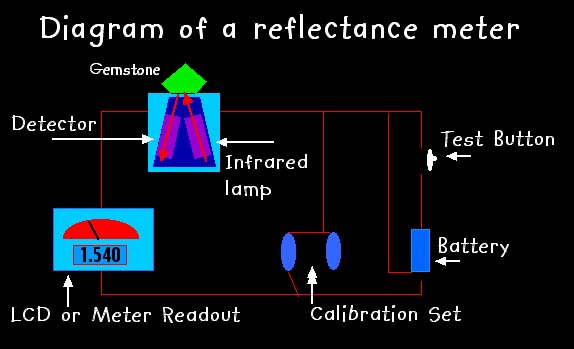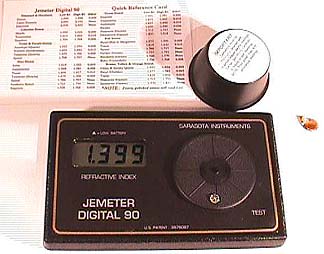


 Jemeter
Jemeter
General Information
What is it?: It was a sad day for gemology when Sarasota Instruments of Sarasota, Florida closed their doors and stopped making this handy piece of gemological equipment. The Jemeter is a version of a very important tool that allows gemologists to read refractive index numbers for gemstones above the limit of the refractometer. The unit was available first in a needle readout type design, and then later in a LCD digital readout that was far more accurate as you will see below. There are a number of new reflectance meter designs coming out on the market, but their price makes them out of the reach of many grass roots gemologists. And none will come close to being as easy to use and as durable as the Jemeter.
At one point in time the GIA division that sells gemologist equipment, GEM Instruments, offered the Jemeter. But it did not last long. The word I personally got from Sarasota Instruments was that Gem Instruments wanted the license to manufacture the unit, which would have made it more profitable for them. But Sarasota Instruments would not allow anyone else to make the unit, which caused the GIA branch to drop them from the catalog, which it turn caused everyone to think there was something wrong with them. And shortly thereafter, the Jemeter lost favor with US gemologists, which in turn caused Sarasota Instruments to go out of business. Which was very sad indeed. And a classic case of politics over-riding common sense when it came to a very useful and viable instrument.
How does it work?: The Jemeter works on the principle of the infra-red reflectance meter. Sending a beam of infra red light onto the surface of the gemstone, and then reading the results of the gemstones reflecting of the light. The unit uses a photo detector to read the change in speed, and to translate that reading into a read out of refractive index. At first the readout was a needle meter. Later on a LCD digital readout was developed that allowed for a easier read and a more accurate read. Here is the lay out of the basic reflectance meter like the Jemeter

How do I use it to get a refractive index? Its as easy as anything can get. Clean your stone, put it on the meter, and press the button. The three things you will have to do, however, is to make sure the stone is clean, make sure the Jemeter is properly calibrated, and practice with some known stones to make sure you understand that variances of readings that you can get. Mainly because the Jemeter will give readings that are a bit different for some gemstones. For instance, sapphires will read 1.73 - 1.76 on the Jemeter. Now we all know that sapphires should be around 1.76 to 1.77. But this is just a quirk of the Jemeter. But if you have a blue stone that is reading in the 1.73 - 1.76, you will know you have a sapphire if you know your Jemeter. Beyond that, the Jemeter is a great tool for gemologists who travel. The Jemeter 90 below has traveled with YourGemologist for over 500,000 miles around the Caribbean for 10 years and never needed any work on it. So they are very durable and once you get used to how different stones read, you will never go back to a refractometer.
Which is why YourGemologist rarely uses a refractometer....because I have a Jemeter. (Actually I have three)
| N Warning!: The older needle readout models should be checked out thoroughly by an experienced gemologist before you purchase. Some of the older models can no longer be calibrated properly. |
How do they work?
Here are examples of the two types of Jemeter and how they work:
 The Jemeter Digital 90 with
readout and stone cover
The Jemeter Digital 90 with
readout and stone cover
 Back of the unit where battery
is changed
Back of the unit where battery
is changed
 4 Screws and back comes off for
easy battery change:9v
4 Screws and back comes off for
easy battery change:9v
 Jemeter 90 showing where stone
goes for reading, cover, and readout chart
Jemeter 90 showing where stone
goes for reading, cover, and readout chart
 Jemeter with amethyst about to
be placed over detector hole
Jemeter with amethyst about to
be placed over detector hole
 Amethyst refractive index of
1.54 on LCD readout
Amethyst refractive index of
1.54 on LCD readout
If this seems really simple and a no-brainer to learn, its because it is. Now you know why I like traveling with a Jemeter and not a refractometer. And why I am so upset that Sarasota Instruments went out of business....Let's continue....
 Jemeter about to read a peridot...stone
goes on and then the light cover
Jemeter about to read a peridot...stone
goes on and then the light cover
 Peridot reading of 1.65. And
when you turn stone, you can read birefringence RI
Peridot reading of 1.65. And
when you turn stone, you can read birefringence RI
 A diamond refractive index on the
Jemeter
A diamond refractive index on the
Jemeter
 Synthetic Moissianite on a Jemeter
(don't you wish you had one of these?)
Synthetic Moissianite on a Jemeter
(don't you wish you had one of these?)
 The older model needle readout.
This one was made in 1987.
The older model needle readout.
This one was made in 1987.
 Battery changes from the rear.
"D" cell battery
Battery changes from the rear.
"D" cell battery
 Needle readout with amethyst and
red test button
Needle readout with amethyst and
red test button
 Just put stone over hole and push
button for reading of 1.54 +-
Just put stone over hole and push
button for reading of 1.54 +-
Now, here comes the problem with the older needle meter readout models. This one has been calibrated as far as it will go and it is still reading too low in the upper RI region. You will notice in the photo below that the needle is reading about 1.69 for this sapphire. Too low for a novice...but if you know your needle readout Jemeter, you will recognize this reading. But...the needle is very inaccurate for a really serious RI reading in my opinion. Which is why I urge you to seriously think about this needle meter model before buying one on eBay or somewhere else. Be prepared to have a hard time calibrating them, and reading them. Let's continue....
 Sapphire reads at about 1.69
Sapphire reads at about 1.69
 Here a diamond reads about 2.3
Here a diamond reads about 2.3
 And finally, our synthetic moissanite
reads about 2.40...where a diamond should be reading.
And finally, our synthetic moissanite
reads about 2.40...where a diamond should be reading.
You can see the pitfalls of the needle meter Jemeter. So before you buy one remember that you are not getting the most recent technology that was available. And you may well be disappointed. However......and please read this....if you buy one and use it a lot on known gemstones, you will learn how to read what it is telling you. So if you have already bought one, or know of a needle meter model available that you are thinking about...if its cheap enough you might want to go ahead and get it. Because if nothing else it will let you know the approximate reading above the limit of the refractometer, and a bit of practice will allow you to learn what your own Jemeter is telling you as a back up test when you need one for synthetic moissanite...as an example.
This is the basic use of the Jemeter....and the reflectance meter in general. There are other types of reflectance meters out on the market right now, with others coming along very soon. So keep on the look out and so will I. I seriously regret that Sarasota Instruments stopped making the Jemeter. It only cost about US$300.00 and was built to last. But hopefully someone else will come along with a new model. But right now, what I have seen on the market is expensive. Only time will tell if we will find a cost effective replacement of this very important gemological tool that was taken from us long before it was time.
Please note:
All photographs and all text on this page are © Copyright 2002 by YourGemologist.com
I prefer not to have to mess
up the photographs with a bunch of copyright notices so please
respect the copyright for the sake of everyone else who visits
this site.